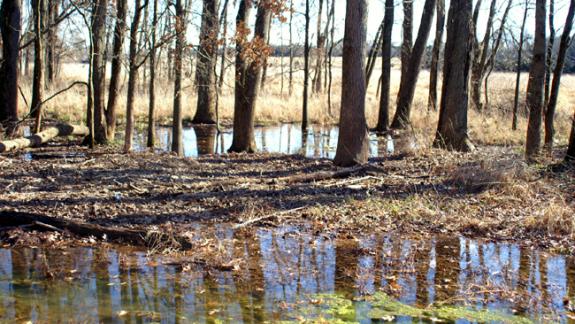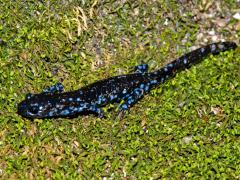Blue-Spotted Salamander
As winter draws to a close, there is perhaps no more faithful a reminder of the onset of spring than the return of amphibians to woodland vernal pools. Among the earliest to arrive is the State endangered blue-spotted salamander.
 Typical habitat of the blue-spotted salamander.
Typical habitat of the blue-spotted salamander.
The blue–spotted salamander, Ambystoma laterale, is a member of a family of salamanders referred to as “mole salamanders,” spending most of their lives underground in abandoned small mammal burrows or under rocks or logs. Blue-spotted salamanders average 3 ½ to 5 ½ inches in length, are stout bodied and have a broad head with a wide mouth. They have a dark background color with light-blue flecking. Blue-spotted salamanders have a very limited range in New Jersey, occurring only in the Passaic River basin and in a few remote sites in Warren and Sussex counties. Due to their “endangered” status and predominantly subterranean existence, they are not often encountered. They are most likely to be observed during their spring migrations to temporary ponded wetlands know as vernal pools.
Vernal pools are isolated depressions with no inlet or outlet stream. They pond due to the collection of surface water from rainfall or flooding or intersection with seasonally high groundwater. Since these sources vary dramatically throughout the year, the depth of water changes with the seasons. By late summer vernal pools dry out completely. This precludes the establishment of a resident fish population, yet vernal pools function much like a small pond for as many as 9 months of the year.
As blue-spotted salamanders evolved, they developed adaptations which made it possible to breed in these temporary pools to avoid the pressures and perils of predatory fish. One of the most evident adaptations is the remarkably early start to their breeding season, allowing the species to take maximum advantage of the limited period of ponding. Once early March rains thaw the ground, adults emerge from their subterranean dwellings and embark on nighttime migrations of as far as 600 feet to reach a vernal pool – typically returning instinctively to the very same pool from which they were born. Another adaptation is the “explosive” pace of the breeding season, which lasts for as few as three days and seldom more than 2 or 3 weeks. During this brief period, adults court and mate and females will deposit a modest 200 or fewer eggs singularly or in small clusters on leaf litter or twigs on the floor of the pool. Typical of amphibians, parental care is absent, and adults quickly return to the upland forests, often returning to the same burrow in which they formerly took refuge.
 Zoom+ Blue-spotted salamander. © George Cevera
Zoom+ Blue-spotted salamander. © George Cevera
And now, the real race for survival is on! Despite the cold, eggs mature within one month and hatch into quarter inch larvae. The bushy-gilled larvae are literally mouths with a tail, and for the ensuing 2 to 3 months will consume any living organism they can fit into their ever-growing mouths. Zooplankton and small aquatic invertebrates sustain them to a size of 1 to 2 inches. At this point, their lungs have finally developed and they can metamorph into terrestrial juvenile salamanders, no longer dependant upon the pool. It is a risk-filled reproductive strategy. Occasionally seasonal rainfall and weather anomalies such as droughts result in the vernal pool drying too early, before any of the salamander larvae are able to mature. But by adapting to a breeding ecosystem which cannot be used by most other amphibians, blue-spotted salamanders allow their offspring to develop in an environment with significantly reduced risks of predation or competition for resources.
The current “endangered” status of blue-spotted salamanders reflects the fact that both the vernal habitats upon which they depend on for breeding, as well as the mature upland forest they reside in for the remainder of the year have been frequently impacted by development or habitat fragmentation. Blue-spotted salamanders are remarkable species and an important component of New Jersey’s natural heritage. Their emergence this time of year from their wintery dens reminds us that spring always follows winter, bringing with it the promise of a new season.
written by John Heilferty, Principal Env. Specialist, NJ DEP
Find Related Info: Amphibians




